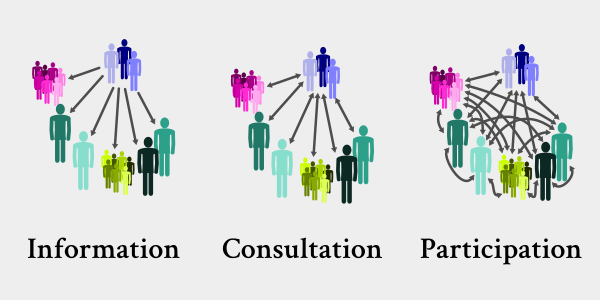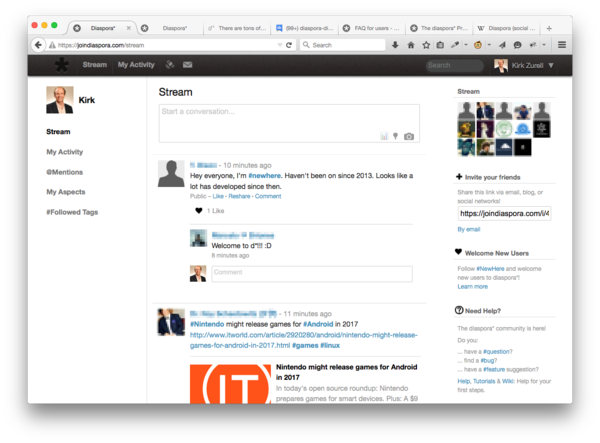Build an “e-Community Centre” with Diaspora
“e-Participation” is following close on the heels of the “Open Data” movement. Where open data is all lists, figures, and co-ordinates, e-participation is about ideas and stories. Open data is about after-the-fact results, e-participation is about before-the-fact values.
Local governments are trying to build engagement by taking policy deliberations directly to residents, using the internet. The online environments they tend to choose appear very earnest and encouraging, but users never have any doubt they’re “doing government”, with results to match.
There do exist some technologies that might coax residents into a more multi-dimensional engagement. Diaspora is the example used in this paper.
Where public administrations envision an e-commons or online agora for policy discussion, social media could provide an “e-community centre” with a far broader scope.
In a brick-and-mortar community centre, all interactions, public and private, go toward building and engaging the community. Public participation in policy development is just one of the activities that take place, and not always a prominent one. But it is easier when done within familiar surroundings and amenities. Would that online community were so hospitable.
e-Participation and Social Media
Governments occasionally admit to themselves they want broader, multi-dimensional models of participation; this alone takes courage.

In some cases, governments try to reach out by putting energy into commercial social media like Facebook and Twitter. Residents are very comfortable with social media, among over a billion people around the world. They willingly use private-sector social platforms to share and discuss everything about their lives, public or personal, sometimes to excess. That’s real engagement.
However effective, using mainstream social media for participation is impolitic for many obvious reasons. Worst of all, governments are essentially handing their citizens over to advertisers, and to the intelligence gathering of whatever jurisdiction hosts the service.
The other option favoured by public administrators is a purpose-built deliberation and decision website. In many cases, staffers use them to create form-filling exercises and top-down consultations.
As user-friendly as they might be, there’s little reason for residents to build up day-to-day familiarity with focused e-participation sites; government is just not an every day thing. The results are similar to real-world public meetings, with small turnouts making under-developed contributions.
If social media users won’t adopt e-participation, e-participation should find social media that meets its constraints.
Diaspora
Congratulations to Diaspora on its latest “0.5.0.0” release. Since 2012, the project has maintained momentum among a small group of volunteer developers and a reported user community numbering at about six figures.

Diaspora is social media. It has the cosmetic appearance of a sparse Facebook clone, but it’s very different underneath, both technically and philosophically.
It’s a social media platform created out of free software, open for anyone to deploy and augment. It provides a web site to users and manages a database of their information and connections. It’s written in “Ruby on Rails”, a mature web application infrastructure.
Diaspora users can connect with each other around the world, and share their ideas and reactions online. Importantly, they can be sure that they stay in control of that data; privacy is one of Diaspora’s cornerstone values.
Diaspora is also decentralized and distributed, like the underlying internet itself. Users join the greater Diaspora by choosing a provider that suits them, local or otherwise. They might pay that provider (or tolerate ads) to obtain the service. Or they might become their own provider, running the software on their own computer, a perfectly compatible practice.
How can many participants connect in an environment created by many independent providers, and expect to keep control of their personal information? Diaspora providers are “federated”, working in a coordinated way while still remaining separate.
Though Diaspora is served from many places, under the control of many site administrators, it provides a protocol that all administrators abide by. Facebook, for comparison, almost certainly has one locus of central administrative control (no matter where its many servers are located).
It takes courage to throw open the doors and become a social media provider. Users will be polite and constructive, or not. Diaspora does not insist that users identify themselves authoritatively (not that many netizens do anyway). But it does allow other users to flag inappropriate content, and a site’s administrators do retain standard administrative controls within Diaspora and outside of it.
Use Case for e-Participation
This paper isn’t intended to pull Diaspora toward e-participation, but rather to coax e-participation toward distributed social media, perhaps Diaspora.
Diaspora’s architecture ticks several important political boxes:
- The same service can be provided commercially by multiple bidders, or in-house,
- Administrative control can remain within a jurisdiction,
- It is open to participation “from abroad”…but not entirely open.
Diaspora harmonizes well with the values of local participatory democracy: local control, openness and transparency, and ease of access. Residents are in general not highly technical, and local government is a grab-bag of unloved concerns. Anything that reduces the barriers to taking part is good.
It won’t meet all expectations as is. The Diaspora project itself doesn’t use its own software for project governance work. Dogfooding is a virtue, but not if the desired workflow just isn’t complete. Core project participants have adopted Loomio, a deliberation and decision-making service. As they are highly technical and committed to a focused challenge, they need no coaxing to use a specialized tool.
It would be a valuable exercise to strip the practices and expectations of e-participation down to their core to see if they add value to a general-purpose social media platform such as Diaspora. Specific proposed enhancements would go through the conventional broad (developer) community consultation to determine their indispensability and irreducibility, with no guarantee of acceptance.
Facebook-type media like Diaspora are tuned to short, snappy conversations, not epic debates or dissertations. Though policy discussions are typically very information-heavy, delegations to formal public meetings are often limited to just a few minutes’ speaking time. A snappy conversation can maintain the backbone of an argument with external sources and links. It’s still unclear how much detail e-participants will tolerate.
A participation workflow that acts like social media can collect and conserve every spark of passion. Collecting passion is key to co-creating government policy. Policy proposals don’t arise fully formed from nowhere:
- A random post about an unloved piece of art might start a discussion about public art in new development projects.
- A notice about a stray cat might resume a lapsed debate about animal bylaws and licensing.
- A picture of a particularly egregious pothole might ignite reviews of the public works budget.
…leading to a formal deliberative motion, or a less formal “there oughta be a law” political message. In a social media-like environment, the audit trail of ideas from first spark to final act will be complete, intact, in a searchable, operable, and analyzable form.
Community Within and Without
For local e-participation, perhaps the most compelling “killer feature” of Diaspora is ironic: it is an emphatically world-wide social network.
A local Diaspora user can share at will with any other user they know from any other site (or “pod”). Links to other Diaspora sites are effectively mandatory, and creating an enclave would take explicit technical measures, and some chutzpah.
If users can share what they want, with whom they want, then Diaspora’s technology mirrors the local community centre experience. They are fully entitled to use a government funded site to conduct private or personal conversations, and there’s little way to, or point in, trying to stop them.
When residents do turn their attention to governing, they build their community by playing a formal local role, while drawing on links to other people in other places. In this way Diaspora models the best and common practices of offline civic life.
Nosy neighbours will, in some cases, weigh in on issues in hometowns not their own. This has both positive and negative implications. Diaspora does allow some privacy, through “aspects”, a distribution-limiting mechanism (also found in Google Plus “circles”). But the bias is toward making participation public.
Success Metrics
It’s a numbers-driven age. e-Participation will succeed if it posts big numbers: lots of members, lots of topics, lots of contributions, all leading to decisive achievements.
Engagement is the momentum that takes participants from one achievement to the next. Any strategy that increases attention to the next topic of discussion is a good strategy. Frequent participation racks up greater social proof, which encourages engagement, which increases proof, and so on.
Governments that just offer e-participants a laundry list of monumental topics, or leading questions, will sorely test engagement. A formal participation site may inspire the privileged procedure wonk, but it will remain unfamiliar and daunting to the casual user.
A freeform stream that looks vaguely like Facebook can, as a side effect, serve as a civic meeting place for everybody. Residents can post what they like, from curious to crucial, in a single entry point. Public servants who take part, the broader group of residents, and others beyond can iteratively refine a topic toward a co-created resolution.
With practice, participants can home in on those people and topics that interest them most. A proven near-addictive social media model is a good basis to encourage practice.
Using social media for e-participation has a different risk profile than that of a structured discussion/decision forum. One of the “risks” is that residents can appropriate the agenda. That may be challenging for bureaucratic thinking, but it harmonizes well with idealized democracy.